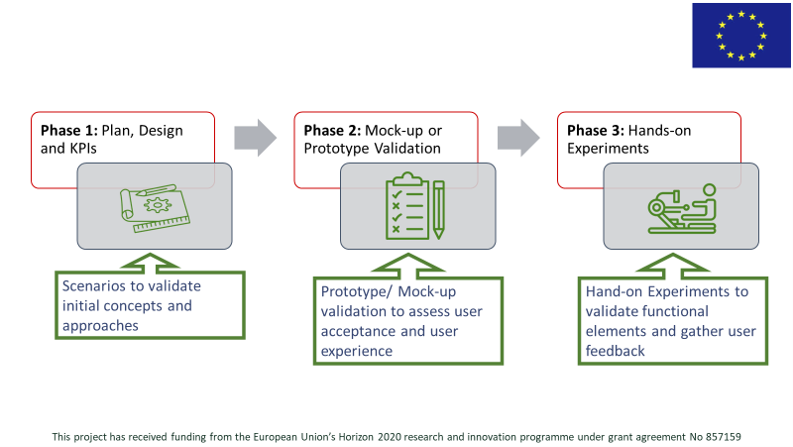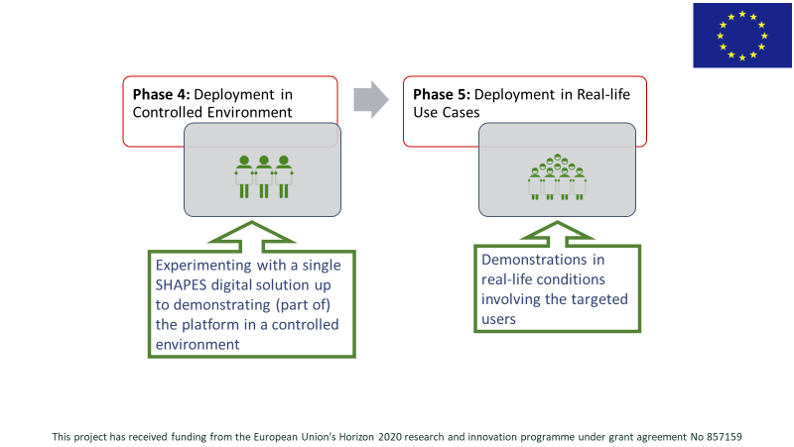SHAPES Pilots
SHAPES – SMART AND HEALTHY AGEING PILOTS
The SHAPES Pan-European Pilot Campaign is about to engage over 2000 older individuals, care givers and care service providers in 36 pilot activities conducted in 15 pilot sites across 11 European Countries, including five EIP on AHA Reference Sites.
The pilot activities are involving hundreds of key stakeholders to address the pressing needs of older individuals, as well as the requirements of Health &Care systems, and bring forward solutions to improve the health, wellbeing, independence and autonomy of older individuals, while enhancing the long-term sustainability of H&C systems in Europe.
Following a methodology approach that considers a timeframe of 24-months, each pilot activity will run in cycles of co-creation and co-design, moving then to the co-experimentation, the co-deployment, and the co-execution, which will all be jointly evaluated.
Link on the links below to access up-to-dated information on each pilot activity.
For more information on the SHAPES’ pilots, you can write to Fraunhofer (Grigoleit, Sonja sonja.grigoleit@int.fraunhofer.de)
Process


Pilot Themes
Aim / Goal / Objective
Use digital technologies to improve living at home, by allowing more independence, healthier habits, and social connectivity.
Target Group
Individuals: people aged 65+ living independently and displaying signs of reduced physical and/or cognitive capabilities and/or functions (physical and/or cognitive), but willing to maintain autonomy, independence and healthy living at home.
Communities: communities involved in activities for older individuals, care service providers and informal caregivers.
Use Case
• Remote In-Home Wellbeing Monitoring and Assessment: For the early identification of risky situations at home and to detect signs of early physical or cognitive decline, unobtrusive monitoring tools will detect anomalies or risky situations, and an alarm will be triggered to the corresponding caregiver so that appropriate intervention is carried out.
• Digital Assistant to Support Older People to Live Independently and Remain Socially Connected: a valid help to remember appointments and/or medications, to keep a balanced diet, etc. can be offered by digital solutions. SHAPES interventions will also act against loneliness and isolation, engaging and communicating with the users.
• Overcoming the fear of digital technologies – competent use of technologies – problem solving in the community: a digital solution for video calls is an easy way to enable social interaction and communication. However, users might fear that calls are recorded and their personal data is misused without their consent. Thus, SHAPES provides a video communication tool for older individuals to easily get in touch with their family and friends while ensuring data protection rights.
Current Pilot Activities
Currently this pilot theme prepares the mock-up testing of the digital solutions to be used in these pilots.
Aim / Goal / Objective
Building a safe and caring environment, by providing an appropriate home setting for older individuals needing care through a specialized nursing service, preferably in addition to care provided by informal caregivers.
Target Group
Individuals: people aged 65+ mostly living on their own, who are in need continuous health and care and of support with technology.
The pilot theme will be implemented in rural (pilot lead) as well as urban areas.
Use Case
• Remote monitoring of key health parameters: Wearables, sensors and other devices can enable individuals to remain independent through the provision of specific tips and recommendations that will be implemented in the pilot activities.
• Supporting the interaction of the individual with the community: the pilot provides easy access to opportunities and developments in the community, such as specialized transport services, readings, bingo, exhibitions and other opportunities to engage in activities taking place in local communities.
• Long Lasting Memories LLM CARE Health and Social Care Ecosystem for Cognitive and Physical training: It combines mental exercises with physical activity for cognitive and physical health, providing effective protection against cognitive decline and thereby actively improving the quality of life.
• Surveillance Rounds at Community Care: Nursing homes are often constrained to bring residents to their rooms quite early for evening retreat. The long evening shifts are often carried-out with a great reduction of staff. Robots can help to detect if anything is wrong providing a function of night-time surveillance. The connected cameras can help to facilitate to see if a resident is unexpectedly leaving his room, identify him and raise alarms on corridor and main doors.
Current Pilot Activities
Currently this pilot theme prepares the mock-up testing of the digital solutions to be used in these pilots.
Aim / Goal / Objective
To identify, manage and improve deficiencies in adherence to medicines and treatments of older individuals living with permanent or temporary reduced functions or capabilities and living at home.
Target Group
Older individuals (+65 years) in domiciliary care with multiple chronic conditions typically respiratory, cardiac, and endocrine conditions.
Use Case
• Supporting multi-morbid older patients: Older individuals tend to have several concurrent medical conditions resulting in the need to take a large number of medicines to help control these conditions. The pilot offers a personalised approach to the safe and effective use of these medicines to ensure the best possible outcomes from their medicines.
• In-home decompensation prediction for heart failure patients: Older people suffering from heart failure must be tightly monitored to avoid decompensations. Medication adherence has been associated with fewer heart failure symptoms and fewer hospitalizations and deaths. Medication is usually re-adjusted after health parameter monitoring (e.g. blood pressure, weight, o2 saturation, cardiac frequency), which becomes an important part of the treatment.
Current Pilot Activities
The pilot sites in this pilot theme together with the technical partner are currently co-developing the specific user requirements of the digital tools to be used in these use cases. Additionally, further external devices and equipment has to be selected to finalize the work on the data plan of the pilots.
Aim / Goal / Objective
To support the physical, social and cognitive well-being through strategies to age healthy and actively and support older people’s adherence and motivation to those interventions.
Target Group
Older individuals living in the community which are active and healthy or which have mild chronic conditions or with chronic musculoskeletal disorders.
Use Case
• Psycho-social and Cognitive Stimulation Promoting Wellbeing: The technical component consists of a dancing surface and respective software that allows for the personalizing of dance choreographies and music and assesses the performance of the user during the choreography. It integrates both a physical and a cognitive component into a ludic and appealing social activity (dancing).
• Cognitive activities for people with early-stage dementia: Studies have shown that cognitive training can have positive effects. A social robot can be an improved channel to give the cognitive tasks in a more personalized and motivating fashion by connecting the robot with a set of cognitive tasks.
Current Pilot Activities
The pilot sites are currently working on the PACT (People-Activities-Context-Technology) and FICS (Function and events, Interactions and usability issues, Content and structure, Style and aesthetics) scenarios of the use cases. They are also planning the recruitment of the participants.
Aim / Goal / Objective
To improve the delivery of care, the management of health conditions and of activities of daily living, and the communication and social well-being.
To minimize the negative effects of caregiving on the psychological health of informal dementia caregivers.
Target Group
Older adults with mild cognitive impairment, which are living independently in the community and are digitally literate or benefit from the support of others. It also includes informal caregivers of people with dementia, which are digitally literate and experience caregiver burden and/or anxiety and/or depression symptoms.
Use Case
• UC-PT5-001 – iSupport for Dementia Caregivers: iSupport is a self-help online program developed by the World Health Organization to provide education, skills training and support to informal dementia caregivers. The pilot focuses on psychoeducational and multicomponent interventions (including, e.g. skills training, psychoeducation, techniques for self-care, changes in the caregiver’s setting) have reunited favourable evidence with regards to its effects on subjective well-being, caregiver burden, depression and anxiety symptoms, skills/knowledge and self-efficacy.
• UC-PT5-002- Monitoring Patients with Mild Cognitive Impairment: eHealthPassTM is a patient centred platform for family health and chronic disease management, that provides a health record’s access, multilanguage information sharing with professionals and relatives, planning and monitoring, emergency support and geolocation. The pilot focuses on self-care behaviours which require cognitive capacity and insight to perform proper self-care, coordination and planning, such as: glucose monitoring, medications, and diet and exercise timing require participation from different domains of cognitive function.
• UC-PT5-003 – Digital Assistance in-home for older people with MCI: A Voice Assistant is just a chatbot that can interact using speech and natural responses; instead of using text, use your own voice. It is composed for two modules: Speech to Text (ST): converts the user’s voice into text; Text to Speech (TS): the other way around, synthesize the text into voice. This pilot focuses on digital assistant impacts to improve the social, mental and physical life of the older adult with mild cognitive impairment through a series of reminders which will enable the individual to retain their autonomy and confidence in their daily lives.
• UC-PT5-004 – Virtual Patient Scenarios & Mobile Virtual Patients: VPS and MVP are branching scenarios that are used extensively in medical education: they are problem-based learning activities aiming at supporting caregivers’ skills with regard to the delivery of care to older people and will be used in this pilot.
Current Pilot Activities
While one use case has already finished successfully phase 1 of the pilot campaign (development of scenarios, user requirements, data plans and KPIs), the other use cases are working on the development of PACT (People-Activities-Context-Technology) and FICS (Function and events, Interactions and usability issues, Content and structure, Style and aesthetics) scenarios.
Aim / Goal / Objective
To safely conduct physical activity and physical rehabilitation routines. To correctly supervise rehabilitation routines and boost motivation.
Target Group
Older adults that either need to recover from a certain accident or health issue (e.g.: stroke, fall, surgery, rheumatoid arthritis, osteoarthritis, orofacial disorder etc.) but also those who, without having to recover from a specific problem, benefit from physical activity, preventing or improving frailty conditions.
Use Case
• Training of orofacial musculature: a digital tool is used to present the face gestures to be carried out by the affected individual, measure the performance and motivate the patient.
• Gait rehabilitation: a robot will be used to guide and support the patient in gait rehabilitation.
• 3D Depth Camera Rehabilitation Tool: In this case a 3D camera will guide the patient through the rehabilitation process.
• Wearable Motion Monitoring Devices: In this use case a wearable motion monitoring device attached to the user’s shoes (both shoes) and in a wristband is used to track the evolution of rehabilitation processes and the condition of the user.
Current Pilot Activities
This pilot theme has entered the co-working phase between the pilot sites and the technical partner to develop the user requirements of the use cases.
Aim / Goal / Objective
Pilot Theme 7 addresses multiple aspects associated with the mobility and accessibility of older individuals – namely the availability of health and care data (exchange) across Europe – including those living with permanent or temporary reduced functions or capabilities, to access health and care services anywhere while traveling. Accessibility of older individuals, and of those experiencing physical disability, visual impairment (blindness) and hearing impairment (hard-of-hearing, deafness, deafblindness), is also addressed in the different piloting activities from the perspective of the accessibility level of buildings and outdoor environments, which tend to affect the older individuals’ mobility, and thus their decision-making process with respect to traveling.
The planning of PT7 focuses on delivering and demonstrating SHAPES’ two main capabilities:
A) To ensure continuous availability of health care data for both patients and their caregivers – safely and securely – wherever they may be
B) To provide information and navigation for safe and accessible travelling sites and destinations
Target Group
Older people suffering from chronic diseases (Heart Failure, Type II Diabetes, Chronic Obstructive Pulmonary Disease) and older people with physical disabilities (including deafness, blindness and deafblindness).
Use Case
•Monitor older patient with chronic disease when travelling abroad:The rationale behind this use case is to demonstrate the capability of SHAPES Digital Ecosystem to support availability and access to physiological and medical data, for the patient and for the patient’s formal and informal caregivers, when the former travels abroad. Patient and health professional should be able, through SHAPES Ecosystem, to manage the disease and communicate face to face – as effectively as in a session conducted in the doctor’s office or patient’s home.
• Foster older people’s (with physical disabilities) independent living by identifying accessible locations and routes in other locations (domestic and abroad): This use case shall be used to demonstrate that SHAPES Digital Ecosystem can identify travelling destinations and sites that are friendly and accessible to people with disabilities. SHAPES will access the safety and accessibility levels of potential destinations, suggest routes and sites, provide navigation and assistance, thus enhancing the individual’s confidence to make an informed decision in selecting a tourist destination and/or activity.
• Preventing and/or handling a medical emergency while visiting another country: The third use case in pilot theme 7 extends the capability of UC-PT7-001, by elevating on the features of data (availability / access / processing) and communication. Two major aspects of a medical emergency shall be put to test for the SHAPES Ecosystem: Prevention and handling.
The former relies heavily on data analysis and assessment. The SHAPES Ecosystem shall analyse and assess the patient’s health and lifestyle data so that it may detect anomalies and/or harmful patterns, thus predicting possible critical or life-threatening events. Consequently, it will generate the appropriate alerts (to the patient and accompanying family member), e.g. to take rest, medication, return to hotel, etc. or alert the patient’s doctor back home to initiate a videoconference for further advice. In addition, SHAPES can find and plot a route to the nearest health care facility (alerting the facility, as well) for the patient to seek immediate treatment.
The latter is based on sharing and exchanging the patient’s medical history between different systems. In case of a medical emergency, the SHAPES Ecosystem will be able to provide a medication and patient’s summary, along with the capability to establish a direct communication channel between the emergency physician, the patient’s physician and the patient, for further consultation and guidance, in order to perform the best informed medical practice.
Current Pilot Activities
Pilot theme 7 is currently co-working with the technical partners to decide on further external devices and equipment (e.g. fitness tracker, sensors, etc.) and the data plan of the use cases as well as on necessary procurement processes regarding the purchasing of this equipment

